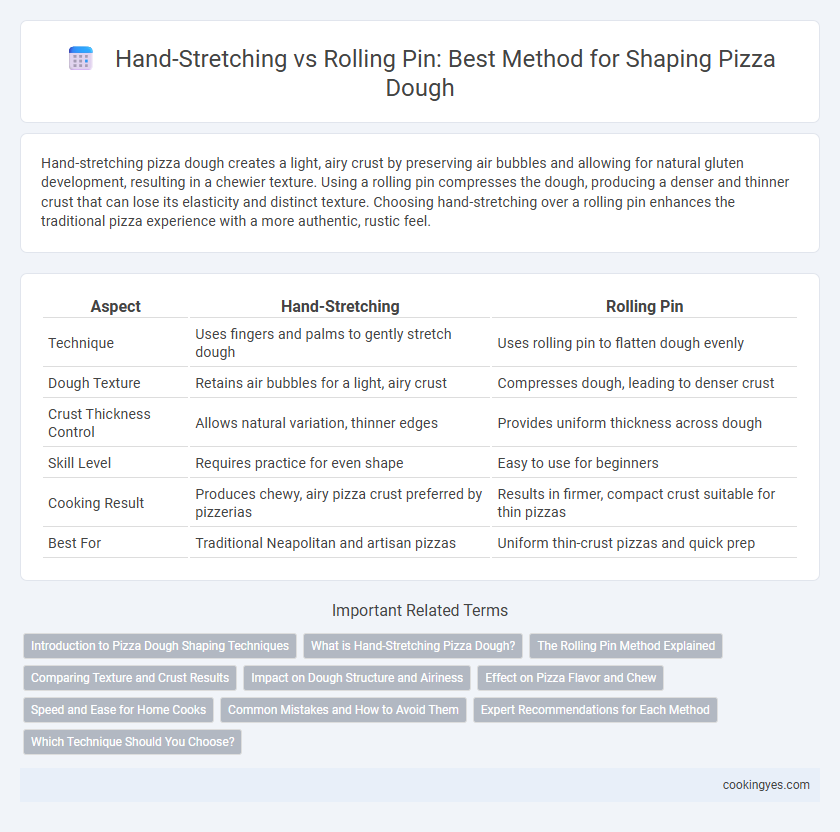Hand-stretching pizza dough creates a light, airy crust by preserving air bubbles and allowing for natural gluten development, resulting in a chewier texture. Using a rolling pin compresses the dough, producing a denser and thinner crust that can lose its elasticity and distinct texture. Choosing hand-stretching over a rolling pin enhances the traditional pizza experience with a more authentic, rustic feel.
Table of Comparison
| Aspect | Hand-Stretching | Rolling Pin |
|---|---|---|
| Technique | Uses fingers and palms to gently stretch dough | Uses rolling pin to flatten dough evenly |
| Dough Texture | Retains air bubbles for a light, airy crust | Compresses dough, leading to denser crust |
| Crust Thickness Control | Allows natural variation, thinner edges | Provides uniform thickness across dough |
| Skill Level | Requires practice for even shape | Easy to use for beginners |
| Cooking Result | Produces chewy, airy pizza crust preferred by pizzerias | Results in firmer, compact crust suitable for thin pizzas |
| Best For | Traditional Neapolitan and artisan pizzas | Uniform thin-crust pizzas and quick prep |
Introduction to Pizza Dough Shaping Techniques
Hand-stretching pizza dough preserves the gluten network, resulting in a chewier, airier crust with irregular bubbles that enhance texture. Using a rolling pin compresses the dough, producing a thinner, denser crust with a uniform thickness but less lift and chewiness. Mastering hand-stretching is favored by traditional pizzerias aiming for authentic, wood-fired pizza characteristics.
What is Hand-Stretching Pizza Dough?
Hand-stretching pizza dough involves using the hands to gently pull and stretch the dough into a thin, even circle, preserving its air bubbles for a light and chewy crust. This traditional method enhances dough texture by avoiding overworking the gluten, which can happen with rolling pins. Professional pizzerias prefer hand-stretching to achieve an authentic Neapolitan-style pizza with optimal crust elasticity and flavor.
The Rolling Pin Method Explained
The rolling pin method for pizza shaping involves evenly flattening the dough to a consistent thickness, which ensures a uniform bake and crisp crust. This technique allows better control over the size and thickness, particularly useful for thinner styles like New York or thin-crust pizzas. Using a rolling pin can prevent air pockets in the dough, resulting in a denser texture compared to the airy, chewy outcome achieved through hand-stretching.
Comparing Texture and Crust Results
Hand-stretching pizza dough preserves more air bubbles, resulting in a lighter, airier crust with a chewy texture preferred in Neapolitan-style pizzas. Using a rolling pin compresses the dough, producing a denser crust with a uniform thickness and a crispier edge typical of Sicilian or thin-crust pizzas. Texture differences are key: hand-stretched dough yields a softer bite, while rolled dough delivers a firmer, crunchier crust.
Impact on Dough Structure and Airiness
Hand-stretching pizza dough preserves its delicate gluten network by gently elongating the strands, resulting in a lighter, airier crust with better oven spring. Using a rolling pin compresses the dough, flattening air pockets and leading to a denser, less textured crust due to the diminished gluten structure. The choice between these methods directly impacts the pizza's final texture, with hand-stretching favoring a more open crumb and enhanced chewiness.
Effect on Pizza Flavor and Chew
Hand-stretching pizza dough preserves its air bubbles, resulting in a lighter, more flavorful crust with a distinct chewy texture. Using a rolling pin compresses the dough, reducing air pockets and leading to a denser crust with less complex flavor development. The traditional hand-stretching method enhances both the pizza's aroma and overall mouthfeel, creating a superior eating experience.
Speed and Ease for Home Cooks
Hand-stretching pizza dough allows for faster shaping and better control over thickness, making it ideal for home cooks seeking quick preparation. Using a rolling pin can be easier for beginners, providing uniform thickness but may sacrifice dough texture and elasticity. For speed and ease, hand-stretching often leads to a more authentic, pizzeria-quality crust in less time.
Common Mistakes and How to Avoid Them
Using a rolling pin for pizza dough often results in uneven thickness and a dense crust due to overworking the gluten, whereas hand-stretching preserves air bubbles for a light, airy texture. A common mistake in hand-stretching is applying too much pressure, which can tear the dough, so gently rotating the dough while letting gravity aid the stretching is essential. Avoid pressing down with fingers or using excessive force by supporting the dough's edge and allowing it to stretch naturally to maintain an even, perfectly shaped pizza base.
Expert Recommendations for Each Method
Experts recommend hand-stretching pizza dough to preserve the airy crumb and achieve a light, chewy crust favored in Neapolitan-style pizzas. Using a rolling pin is advised for thinner, more uniform crusts typical in Sicilian or New York-style pizzas, as it ensures consistent thickness and even baking. Professional pizzaiolos emphasize that hand-stretching enhances dough texture by maintaining gas bubbles, while rolling provides control for sturdier bases suitable for heavy toppings.
Which Technique Should You Choose?
Hand-stretching pizza dough preserves air bubbles, resulting in a lighter, chewier crust with a more artisanal texture, while rolling pins create uniform thickness but can compress the dough, leading to a denser crust. Professional pizzerias often prefer hand-stretching because it enhances the crust's flavor and texture, whereas home cooks may opt for rolling pins for ease and consistency. Choosing between hand-stretching and rolling pin depends on your desired crust quality and skill level, with hand-stretching favored for authenticity and rolling for convenience.
Hand-stretching vs Rolling pin for pizza shaping Infographic

 cookingyes.com
cookingyes.com